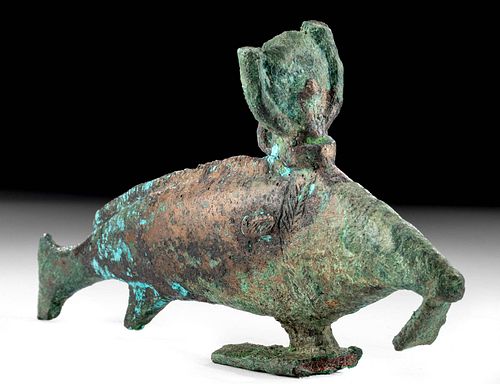Egyptian Leaded Bronze Oxyrhynchus w/ Crown of Hathor
Lot 4
About Seller
Artemis Fine Arts
686 S Taylor Ave, Ste 106
Louisville, CO 80027
United States
Selling antiquities, ancient and ethnographic art online since 1993, Artemis Gallery specializes in Classical Antiquities (Egyptian, Greek, Roman, Near Eastern), Asian, Pre-Columbian, African / Tribal / Oceanographic art. Our extensive inventory includes pottery, stone, metal, wood, glass and textil...Read more
Estimate:
$600 - $900
Absentee vs Live bid
Two ways to bid:
- Leave a max absentee bid and the platform will bid on your behalf up to your maximum bid during the live auction.
- Bid live during the auction and your bids will be submitted real-time to the auctioneer.
Bid Increments
| Price | Bid Increment |
|---|---|
| $0 | $25 |
| $300 | $50 |
| $1,000 | $100 |
| $2,000 | $250 |
| $5,000 | $500 |
| $10,000 | $1,000 |
| $20,000 | $2,500 |
| $50,000 | $5,000 |
| $100,000 | $10,000 |
| $200,000 | $20,000 |
About Auction
By Artemis Fine Arts
Oct 22, 2020
Set Reminder
2020-10-22 10:00:00
2020-10-22 10:00:00
America/New_York
Bidsquare
Bidsquare : Ancient & Ethnographic Art Through The Ages
https://www.bidsquare.com/auctions/artemis-gallery/ancient-ethnographic-art-through-the-ages-5850
Ancient art from Egypt, Greece, Italy and the Near East, as well as Asian, Fossils, Pre-Columbian, Native American, African / Tribal / Oceanic, Fine art, and much more! All categories, all price ranges... all legally acquired and guaranteed to be as described or your money back. Artemis Fine Arts info@artemisfinearts.com
Ancient art from Egypt, Greece, Italy and the Near East, as well as Asian, Fossils, Pre-Columbian, Native American, African / Tribal / Oceanic, Fine art, and much more! All categories, all price ranges... all legally acquired and guaranteed to be as described or your money back. Artemis Fine Arts info@artemisfinearts.com
- Lot Description
Egypt, Late Dynastic to Ptolemaic Period, ca. 664 to 30 BCE. A well preserved and finely detailed figure of an oxyrhynchus (Nile perch) fish cast from leaded bronze with a streamlined aquatic body bearing a segmented dorsal fin, anal and pelvic fins, and a narrow tail. The tapered, conical head bears a pair of narrow eyes and the neckline is incised with a plaited collar pattern. The head is surmounted by the crown of Hathor composed of a sun disc flanked with a pair of bull horns and a frontal uraeus cobra, and behind the crown is an integral suspension loop. Matte layers of green, brown, citrine, and blue-green patina envelop the entire composition. Size: 5.875" L x 3.1" H (14.9 cm x 7.9 cm)
The ancient Egyptians worshipped this fish at the town of Medjed, which, after Alexander the Great's conquest, was renamed to be "Oxyrhynchus" in Greek. The fish played a role in one of the most important stories in Egyptian mythology, attesting to the rebirth and immortality of the god Osiris. Although there are many forms of the myth, the general outline of the story is this: Osiris and his queen Isis ruled Egypt. Osiris's brother, Set, had him murdered, but Isis found his remains. She raised him from the dead using the sacred mysteries of mummification and he impregnated her; then he died again, and she hid his body in the desert and gave birth to his son, Horus. Set, enraged, found the remains of Osiris and tore his body into pieces that he scattered throughout the land. Isis gathered all of these pieces up - except the penis, which had been eaten by the medjed. Many towns in Egypt claimed to be places where body parts of Osiris were found - towns could profit from pilgrims and worshippers - and Medjed was no exception. This figure, made of relatively expensive bronze, probably functioned as a ritual item held by a temple, or may have been a votive ornament purchased by a wealthy pilgrim or worshipper.
Cf. The Metropolitan Museum of Art, accession number 04.2.660
Provenance: ex-estate of Eldert Bontekoe, Pegasi Numismatics, Ann Arbor, Michigan, USA, acquired before 2000; ex-private New York, New York, USA collection, acquired in 1968
All items legal to buy/sell under U.S. Statute covering cultural patrimony Code 2600, CHAPTER 14, and are guaranteed to be as described or your money back.
A Certificate of Authenticity will accompany all winning bids.
We ship worldwide and handle all shipping in-house for your convenience.
#158873Losses to areas of original base, tips of bull horns, and tips of tail as shown. Abrasions and softening to some finer details, with light encrustations. Great patina throughout.Condition
- Shipping Info
-
All shipping is handled in-house for your convenience. Your invoice from Artemis Gallery will include shipping calculation instructions. If in doubt, please inquire BEFORE bidding for estimated shipping costs for individual items.
-
- Buyer's Premium



 EUR
EUR CAD
CAD AUD
AUD GBP
GBP MXN
MXN HKD
HKD CNY
CNY MYR
MYR SEK
SEK SGD
SGD CHF
CHF THB
THB
















